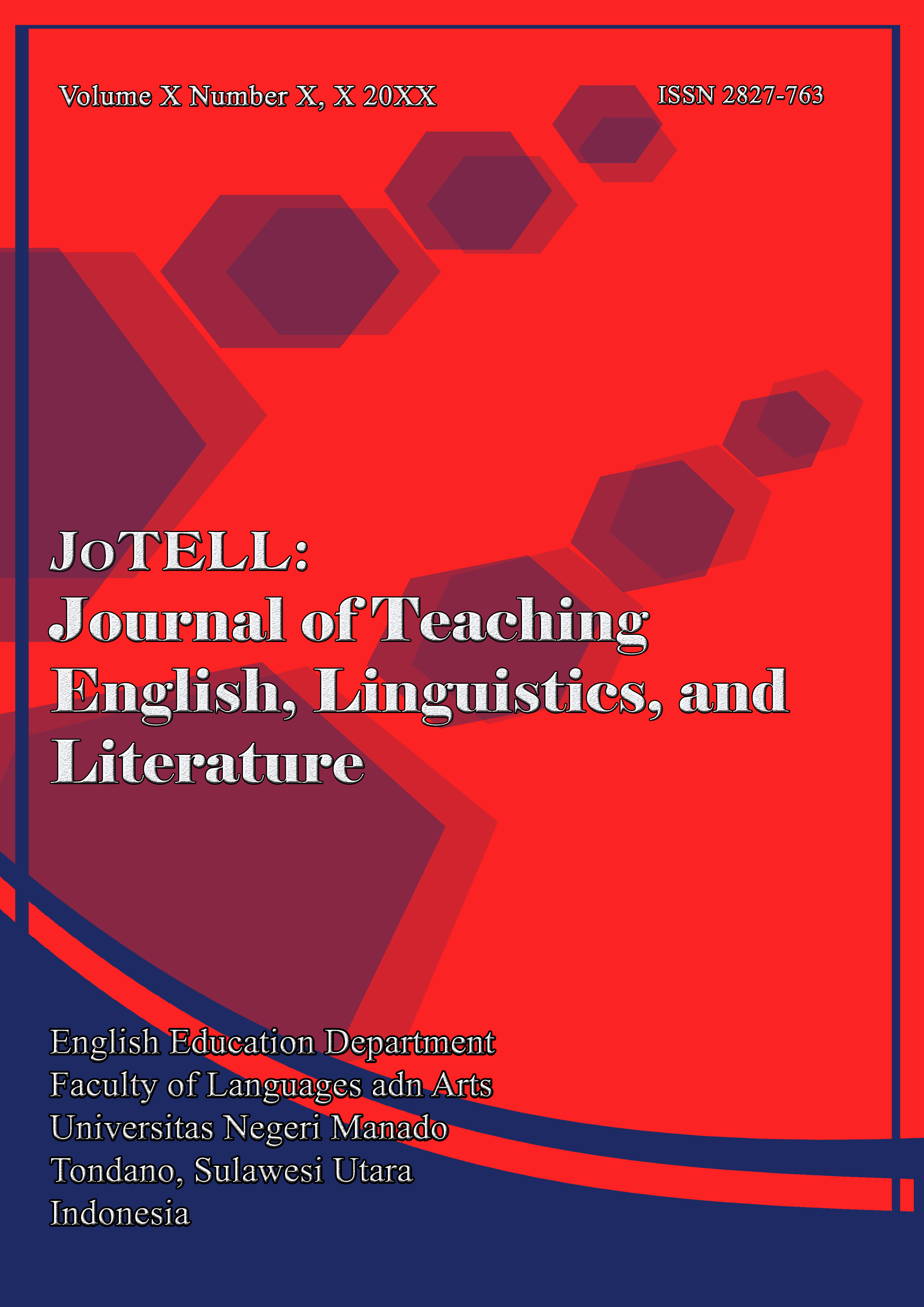AN ANALYSIS OF FIGURATIVE LANGUAGE EXPRESSIONS IN ONLINE SHOP ADVERTISEMENTS
DOI:
https://doi.org/10.36582/jotell.v2i9.7319Keywords:
Figurative languages, advertisement, Youtube, linguistics,semanticsAbstract
This research aims at identifying figurative expressions, their types and meaning in online advertisements. This research applied descriptive method. The subject of this research was advertisements phrases and sentences in online shop advertisements especially that released in Youtube. Based on the findings, It can be concluded that in advertisements, figurative languages are contained. There are various types such as hyperbole, metonimy, metaphor and simile found in online advertisements especially those are accessible in Youtube social platform in video-based database. Each kind of figurative language has different frequency as discovered. Hyperbole has in 15 data (75%), simile has 1 data (5%), metaphor is found in 2 data (10%) and metonimy has 2 data (10%). It is seen that hyperbole has the highest frequency and simile becomes the lowest. Persuasive sentences in online ads are sentences that aim to convince and persuade the reader or listener to carry out the idea expressed in the sentence about something. In making advertisements, people also have to use this type of persuasive sentence because so that readers or listeners feel persuaded to accept the offers in the advertisement. It is a must to pay attention to the use of language which is very important for the success of advertisements in the eyes of the public. The language used in advertisements must be able to be a presentation to the public so that they are interested in something being advertised. It is a must to pay attention to the use of language which is very important for the success of advertisements in the eyes of the public. The language used in advertisements must be able to be a presentation to the public so that they are interested in something being advertised
References
Anwar, K. 2006. Meaning in Advertisements: Philosophy of Language. An Publishing
Baskoro, Adi. 2009. Panduan Praktis Searching di Internet. Jakarta Selatan: TransMedia
Beasley, R. and Danesi, M. 2002. Persuasive Signs: The semiotics of Advertising. Berlin: Walter De Gruyter. http://books.google.co.id/books?id
Bogdan and Biklen. 1992. Qualitative Research for Education; An Introduction to Theory and Methods, second edition.Massacussets: Allyn and Bacon inc.
Bonvillain, N. 2019. Language, culture, and communication: The meaning of messages. Rowman & Littlefield.
Clow, K. E., Baack, D. (2012). Integrated Advertising, Promotion and Marketing
Communications. Edinburgh: Pearson Education
Crystal, David. 1992. Language Play. Chicago: The University of Chicago Press.
Ekoyono, R. D. (2019). Analysis Of Figurative Language Used In English Slogan Of Commercial Beverage Products (Doctoral dissertation, Universitas Pancasakti Tegal).
Fasold, R. W., & Connor-Linton, J. (Eds.). (2014). An introduction to language and linguistics. Cambridge University Press.
Keraf, G. (2010). Kamus Linguistik. Jakarta: Gramedia.
Leech, G.N. 1996. English in advertising: a linguistic study of advertising in Great Britain. London: Longman.
Liando, N. V. F., & Tatipang, D. P. (2022). English or Indonesian Language? Parents’ Perception Toward Children's Second Language Learning Context. Jurnal Lingua Idea, 13(1), 61-75.
Liando, N. V., Tatipang, D. P., & Lengkoan, F. (2022). A study of translanguaging practices in an EFL classroom in Indonesian context: A multilingual concept. Research and Innovation in Language Learning, 5(2), 167-185.
Liando, N. V., Tatipang, D. P., Rorimpandey, R., & Karisi, Y. (2022). Easing the rules of health protocols: A critical discourse analysis of Indonesian president’s speech on Covid-19 handling in 2022. Englisia: Journal of Language, Education, and Humanities, 10(1), 127-145.
Liando, N. V. F., Tatipang, D. P., & Wuntu, C. N. (2023). First Language Interfere in EFL Classes: Revealing Students’ Perspectives and Teachers’ Reasons in ELL. REiLA: Journal of Research and Innovation in Language, 5(1), 77-88.
Liando, N. V., Dallyono, R., Tatipang, D. P., & Lengkoan, F. (2023). Among English, Indonesian and local language: Translanguaging practices in an Indonesian EFL classroom. Indonesian Journal of Applied Linguistics, 13(1).
Liando, N. V., Ratu, D. M., & Sahentombage, V. (2018, February). Vocational High School Students’ Profile and their English Achievement. In IOP Conference Series: Materials Science and Engineering (Vol. 306, No. 1, p. 012094). IOP Publishing.
Pei, Mario A. & Gaynor, Frank. (1980) A Dictionary of Linguistics. New York : Philosophical Library.
Sitompul, Hamzah Nuzulul Fazri. 2014. An Analysis of Figurative Language Use in Commercial Break on Televesion Bengkulu: Universitas Bengkulu.
Suryasa, W. (2016). Figurative language found in printed advertisement. International Journal of Linguistics, Literature and Culture, 2(1), 29-38.
Trehan, M. and Trehan, R. 2006. Advertising and Sales Management. Delhi: Rahul Jain. http://books.google.co.id/books?id
Yule, G., & Widdowson, H. G. (1996). Pragmatics. Oxford University Press.
Downloads
Published
How to Cite
Issue
Section
License
Copyright (c) 2023 JoTELL : Journal of Teaching English, Linguistics, and Literature

This work is licensed under a Creative Commons Attribution-ShareAlike 4.0 International License.












